w/ 001 OS
type: space
function: studio
location: aoyama, tokyo
floor: 30m2
collaborator: fukuwaza(construction)masafumi tsuji(photo)
date: 2022.9
/
Interior design for digital generalist’s studio.
Space is just one room, inside the vintage apartment along the antique street.
骨董通りに建つとあるヴィンテージマンション一室の内装計画。
デジタル・ジェネラリストのスタジオとして、スケルトンから設計をはじめた。
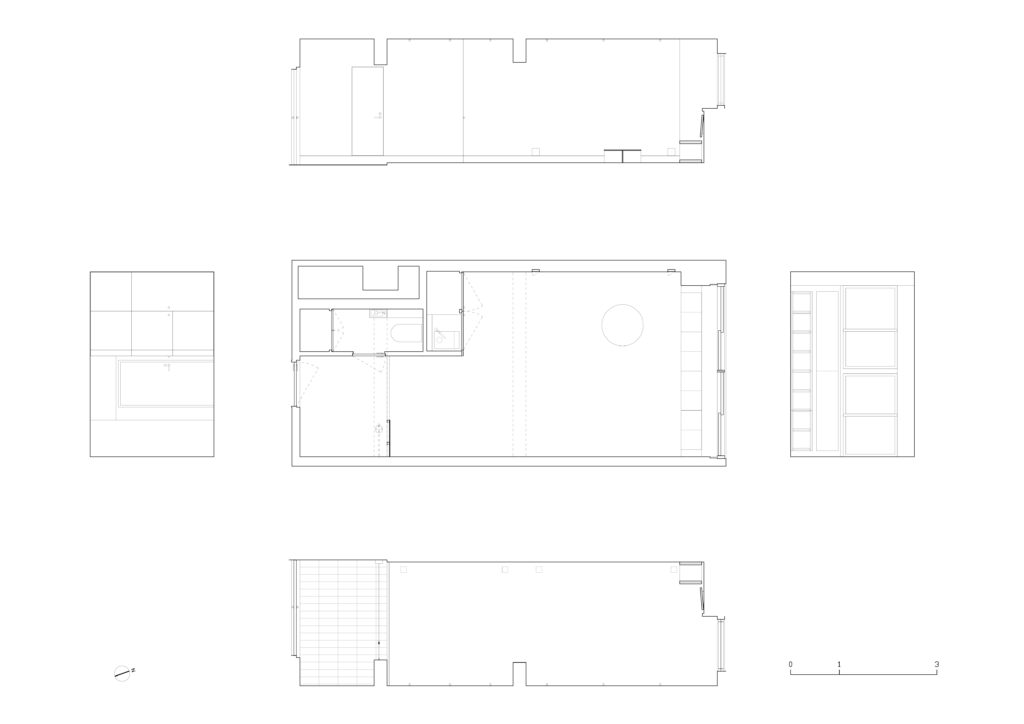
High-ceiling and neutral space is needed. So existing floor and ceiling were removed.
Then concrete slab appeared above/below space.
WC needs to be hidden, and also needs space under floor, so the door is put on the wide baseboard.
Other small doors also put on the baseboard, which hide outlets.
要望は天井を高くすること、それからニュートラルな空間をつくること。
それゆえ、床と天井は剥がされ、コンクリートのスラブが上下にあらわれた。
水回りの床は上がるので、太い巾木の上に、建具を載せることにした。
余計なものはみえないよう、コンセントボックスも太い巾木の上に。
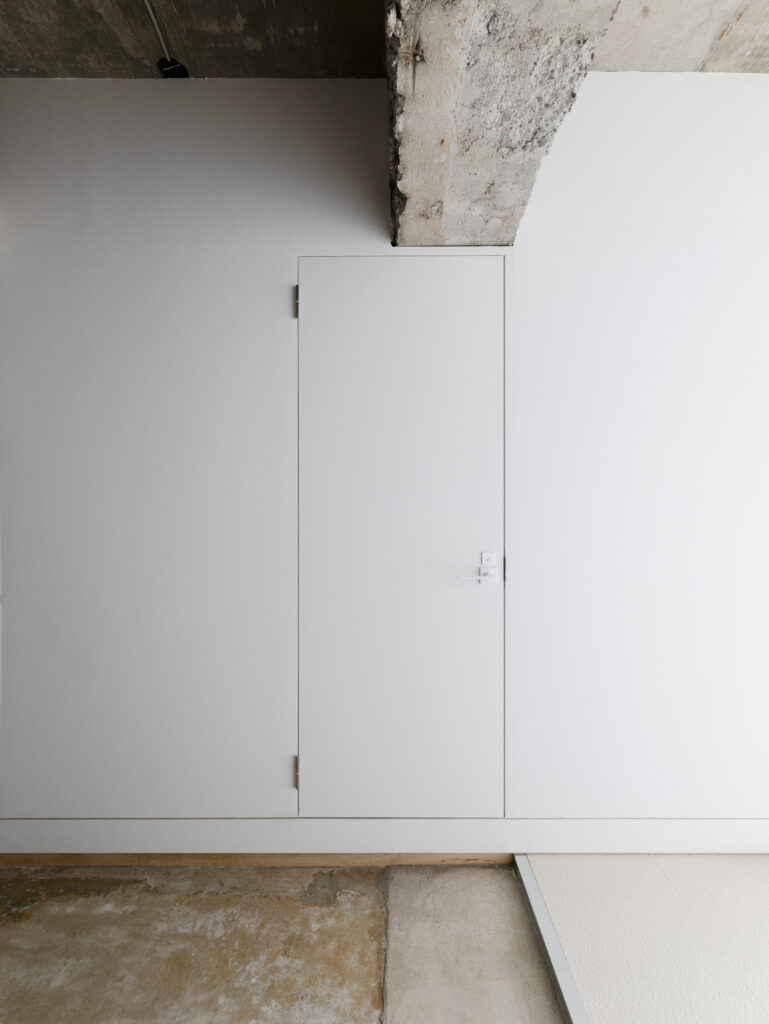
The wide baseboard is characteristic, which separates white carpet floor, white painted wall and doors.
Besides that, partition wall and 5doors(for hidden kitchen) is kind of exception.
Partition wall connects/disconnects finished(white)/unfinished(rough texture) space.
5doors is mimicking wall. But there are joints.
Doors are moving freely, but invisible, only joints are visible.
床の白いカーペットと白塗装された壁を見切る太い巾木の他に、間仕切り壁とキッチンを隠す5枚の扉。
間仕切り壁は仕上げと未仕上げのあいだ。
5枚の建具は壁や巾木に擬態しながら、自由に振る舞う。
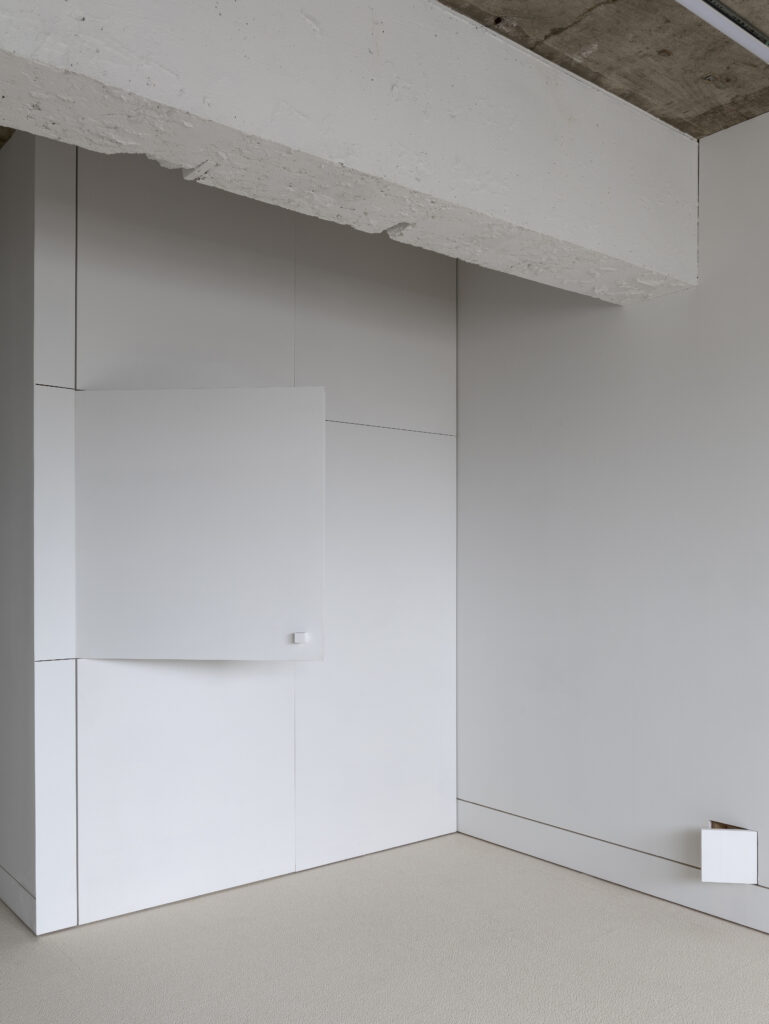
You can see the skyline of a city through the window.
Bench and windowsill have smooth texture which makes dreamy effect as a picture frame.
In fact, square is our theme.
最後に、窓から都市の景色がみえる。
景色を切り取る窓台とベンチのスムーズさが、心を癒す。
ところで、正方形は1つのテーマである。
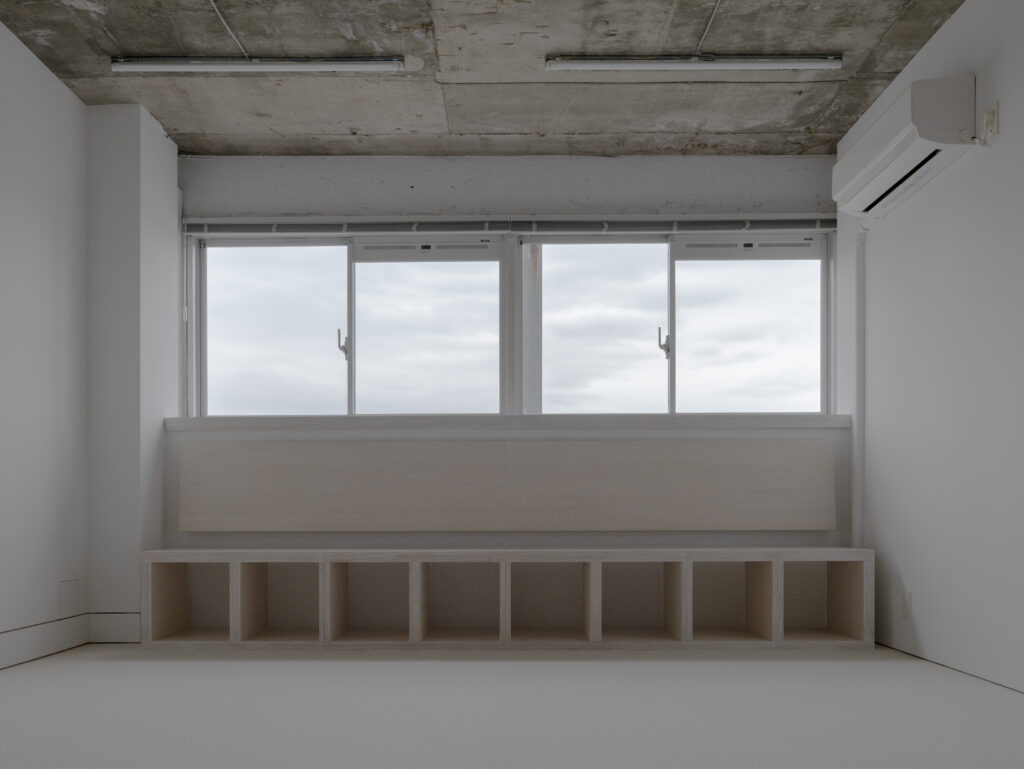
/
On Physical Allegory
身体的寓喩について
I visited the room because I was able to arrange an interview with the designer who lives there. A room in an old apartment building along Kotto-dori in Aoyama had been renovated as the designer’s office. The following is a description of the strange sensations I experienced in that room.
その部屋を訪れることになったのは、居住者であるグラフィック・デザイナーへのインタビューの約束をとりつけることができたからであった。青山の骨董通り沿いに建つヴィンテージマンションの1室が、そのグラフィック・デザイナーのオフィスとしてリノベーションされていた。これから話すのは、その部屋で体験した不思議な感覚についてである。
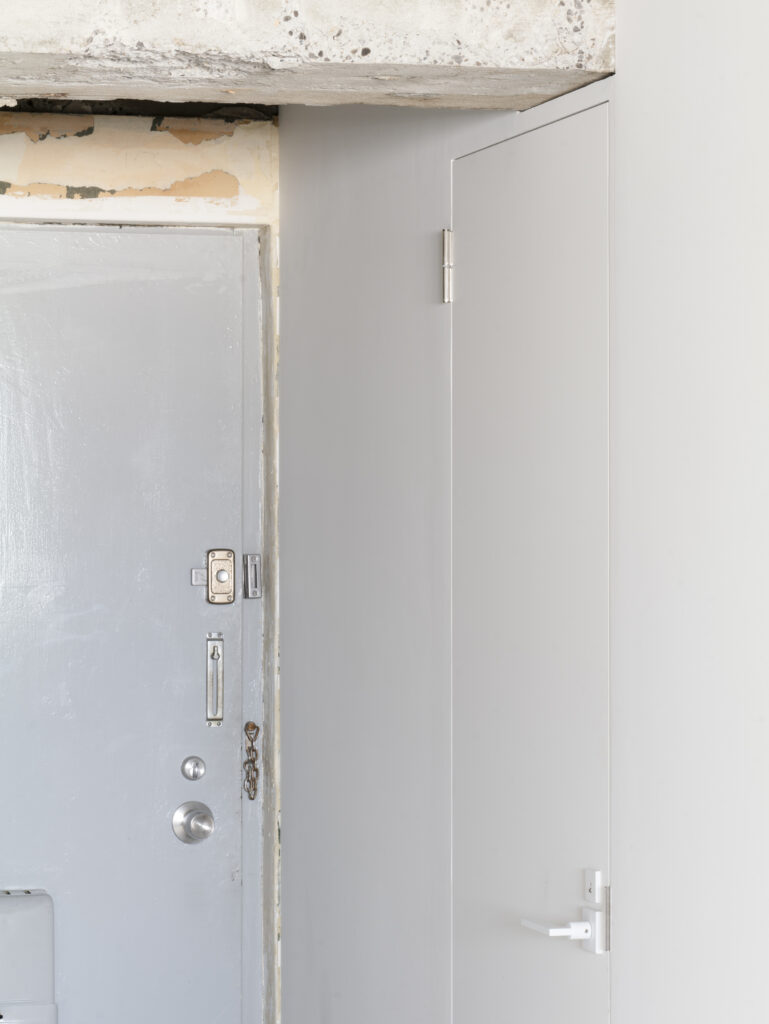
Upon exiting the elevator, I found myself in a dark hallway lined with rooms on either side. After confirming the room number and pressing the intercom, the door opened immediately and I was greeted by the landlord. I remember that the light from the window made the room seem very bright and white. In fact, the contrast with the darkness of the hallway and entrance made the room seem much brighter, and my eyes soon adjusted and I was able to see the details of the room and the scenery outside the window.
エレベーターから出ると両側に部屋が並ぶ仄暗い廊下が続いていた。部屋番号を確認し、インターホンを押すと、すぐに扉が開かれ家主が出迎えてくれた。さっそくなかに入れてもらったのだが、窓からの光によって室内がとても白く明るく感じたことを覚えている。実際には、廊下や玄関口の暗さとの対比によってそれだけ明るく見えたのであって、すぐに目は馴れ、部屋の細部や窓の外の風景がよく見えるようになってきた。
Outside the window, I could see a row of buildings designed as flagships for foreign brands. It was unusual to see these buildings from a different height and direction, and as I stared intently into the room, strangely enough, the buildings seemed to grow larger as I moved deeper into the room. When I told the owner about this sensation, he told me that it was because the brain perceives the size of the building compared to the size of the window frames. In other words, the size of the building hardly changes at all in relation to the rate at which the area occupied by the window in the field of view increases. The reason that such a sense of size is more pronounced in this room than in other rooms is probably because the continuous windows from one end of the room to the other are placed at a height that centers the eye, and the framed outdoor scene is placed in the visual center of the room.
窓の外には海外ブランドのフラッグシップとしてデザインされた建築物が立ち並ぶ様子が見える。いつもとは違う高さ、違う方向から見るそれらの建物の姿は珍しく、まじまじと見つめながら部屋の奥へ進んでいくと、不思議なことに、奥に進むにつれて建物が大きくなっていくような気がした。その感覚を家主に話すと、それは脳が窓のフレームの大きさとの比較によってその建物の大きさを認識しているからだと教えてくれた。つまり、視界において窓の占める領域が大きくなっていく速度に対して、建物の大きさはほとんど変わらないからである。余所の部屋にましてそうした感覚が強く現れるのは、ちょうど目線が中心にくるような高さに部屋の端から端にわたって連続窓が設置され、フレーミングされた外の情景を部屋の視覚的な中央に据えているからなのだろう。
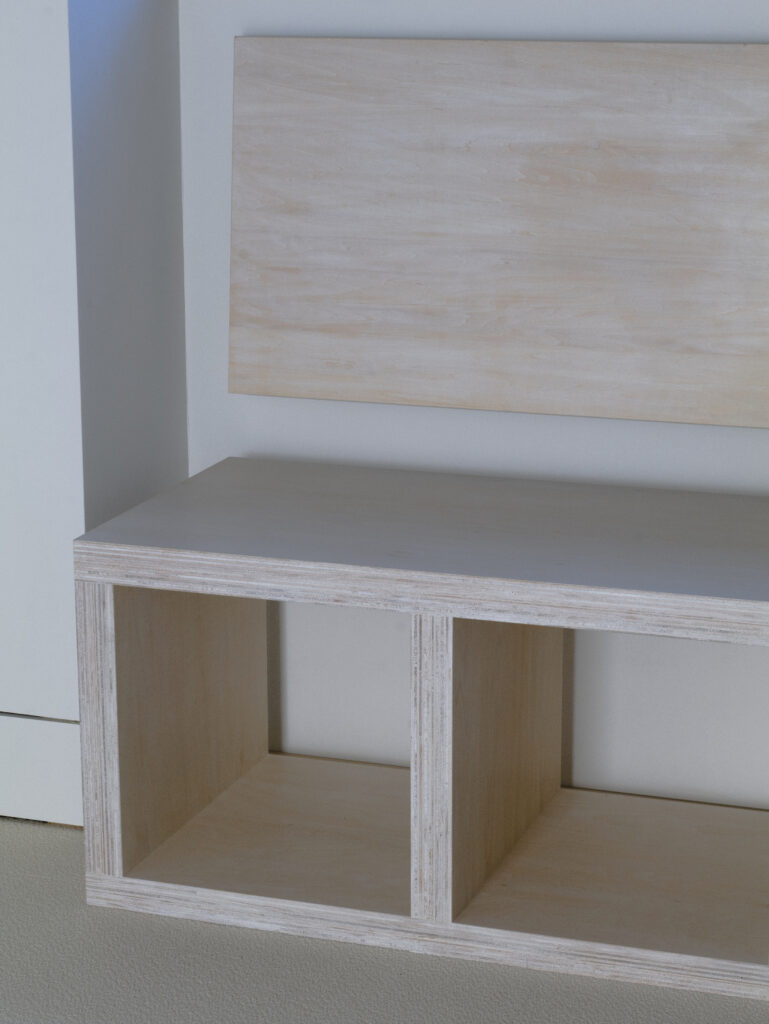
A bench as wide as the window was installed under the window, and a backrest was attached to the top of the bench, i.e. to the wall between the bench and the window. It is interesting to note that the bench formed by a series of squares, the horizontal rectangular backrest, and the horizontal scene cut out by the window, although originally drifting in different places, are all temporarily aligned by the wall with the appearance of having settled in one place. During the interview, I was a little concerned about the meaning of “furniture that looks like it’s about to move” as I listened to him talk about how the best part of computer graphics is that “things that shouldn’t move move”.
窓の下には、窓と同じ幅をもったベンチが据えつけられており、その上部、つまり窓との間の壁には背もたれが貼りつけられていた。正方形の連続で形成されるベンチと横長の長方形の背もたれ、そして窓によって切り取られた水平の情景が、元々はそれぞれ別の場所を漂っていたにもかかわらず、一時的にすっと、ひとところに落ち着いたかのような顔をして壁際に整列しているのが面白い。インタビュー中、「動かないはずのものが動く」のがコンピューター・グラフィックの醍醐味であるという話を聞きながら、「動きだしそうな家具」の意味について少しばかり気を遣っていた。
After the interview was over, I was shown around the room (during the interview I was facing the window, so I didn’t get a good look at the other side of the room, i.e. the entrance). Turning around, we first see the white-painted beams that cross the room. The room was originally created by overwriting the skeleton with a minimum of fixtures, and the contrast between the bare concrete ceiling and entrance and the white, smooth board walls creates a space with an impression of immediacy. The contrast makes the exposed concrete ceiling and entrance transparent and invisible, while only the beams are exposed by being painted white. The only rough-textured beam in the room has a strange presence due to its size.
インタビューが終わり、部屋を紹介してもらう。(インタビュー中は窓の方に向かって話を聞いていたので、部屋の反対側、つまり入口の方についてはじっくり見れていなかった。)振り返るとまず、部屋を横切る白く塗装された梁が目に入る。そもそもこの部屋の空間はスケルトンに最小限の造作を上書きすることでつくられており、打ち放しコンクリートがむき出しになった天井や玄関と、白く平滑な板で構成された壁が対比的に用いられることで、即物的な印象をもった空間が形成されている。対比によって打ち放しコンクリートの天井や玄関は透明化し、その存在が見えなくなる一方で、梁だけが白く塗装されることによってその姿を露にしていた。この部屋のなかで唯一荒々しいテクスチャの梁はその大きさゆえに奇妙な存在感を放っていたのである。
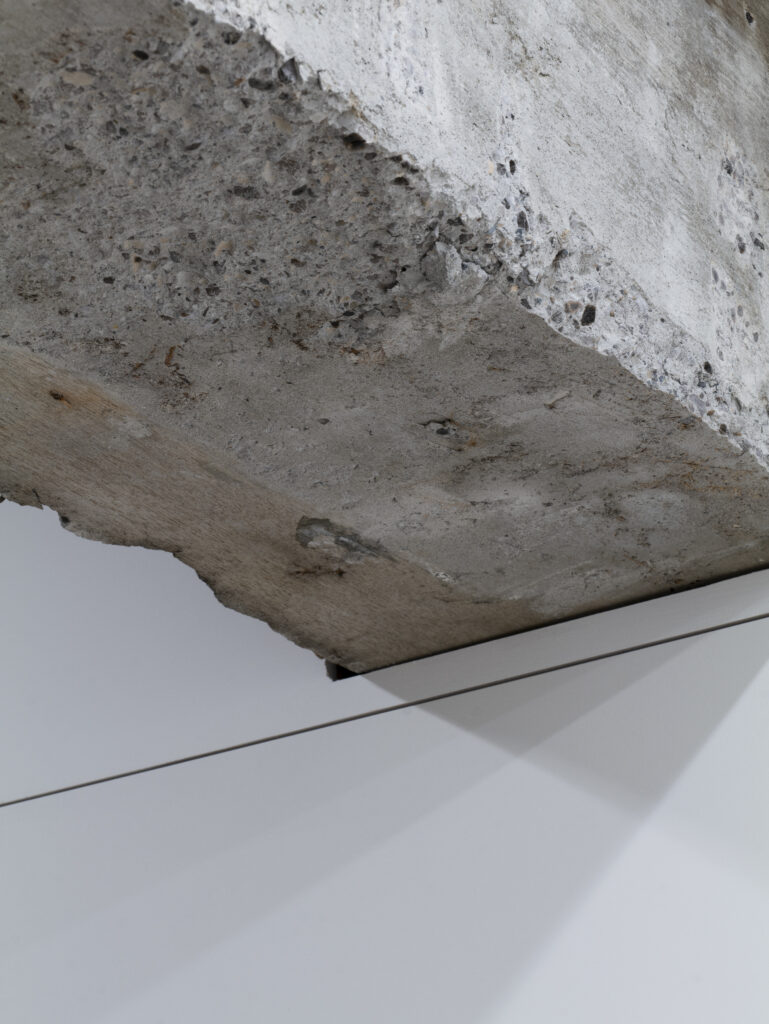
In addition to the beams, niches a few millimeters wide in front of the cupboards, between the floor and the wall, and between the baseboard and the wall formed the impression of this room. These niches were thickly accentuated and their presence added to the impression that the walls and doors were about to move. Like the furniture by the window, it seems as if something that has been in motion is about to settle down and start moving again. It is thought that this impression is created by the fact that there are gaps that seem to sway and move, or seem to have room to move. Such “apparent mobility” (or, following Colin Rowe’s example, “phenomenal mobility”) can be said to create a somewhat unstable yet dreamy atmosphere in this room. As in computer graphics, window frames, cubes, and plate-like materials of various shapes and sizes gathered into a concrete skeleton, instantly forming a spatial structure and then dispersing again. It was a space like a series of microdurational flows.
梁とならぶようにしてこの部屋の印象をかたちづくっていたのが、戸棚の正面や床と壁の間、あるいは巾木と壁の間などに設けられている幅数ミリメートルのニッチである。それらのニッチは太く強調されており、その隙間の存在が壁や扉に「動きだしそうな」印象を付加していた。さきほどの窓際の家具のように、動いていたものが落ち着いて、いつでも再び動きだしそうな状態に見えるのである。隙間があって揺れ動きそう、あるいは動く余地がありそうに見えることがこうした印象を生み出していると考えられる。これらのような「見かけの可動性」(あるいはコーリン・ロウに習って「虚の可動性」とするか)がこの部屋のいささか不安定でありながらも夢見心地な空気感を醸し出しているといえるのではないだろうか。まさに、コンピューター・グラフィックにおいて描かれるように、窓枠や立方体、さまざまな形状をもつ板状の物質が、コンクリートのスケルトンのなかに集まっては、瞬時に部屋のようなものをかたちづくり、そしてまた散らばっていくといった一連の流れのなかの微持続を可視化したような部屋であった。
While trying to put the impression of this room into words, I hypothesized that the distance between the furniture and the walls, floor, and other furniture, which is a prerequisite for the furniture to be a specific and clear object, and the niches, which are deliberately made wider than necessary, give an “apparent mobility” to the furniture and the structure. But is such a floating and dreamy atmosphere really the only impression I had of this room? No, in fact, the first impression that came to my mind was: “It looks like a quarry”. The impression of a “quarry” that momentarily overtook the dreamy atmosphere may have been a memory evoked by the juxtaposition of the rough, white-painted beams, the cabinets on the walls, and the numerous niches carved into the floor. But the impression was so strong and yet so quickly faded that we could not think about it any further at that moment. We thanked him for the interview and left the room.
この部屋のもつ印象を言葉にしようとしているうちに、家具が特定の/明確なオブジェクトであるためにその前提として設けれる壁や床、他の家具との距離や、そして意識的に必要以上の幅をもたされたニッチが、家具や造作に「見かけの可動性」をもたらすということを仮説的に論じてみたが、果たしてそうした浮遊感のある夢見心地な空気感だけがこの部屋に感じた印象だっただろうか。いや、実際のところ頭に最初に浮かんだ印象は、「石切り場っぽいな」だったのではないか。夢見心地なアンビエンスを瞬間的に凌駕して現れた「石切り場」という印象は、白く塗装された荒々しい梁と壁一面の戸棚や足元に刻まれた多数のニッチが並存することによって喚起された記憶のようなものだったのではないだろうか。しかし、その印象は強烈でありながらもすぐに消えてしまったため、その場においてはそれ以上深く考えることができなかった。わたしたちはインタビューの礼を言ってその部屋をあとにした。
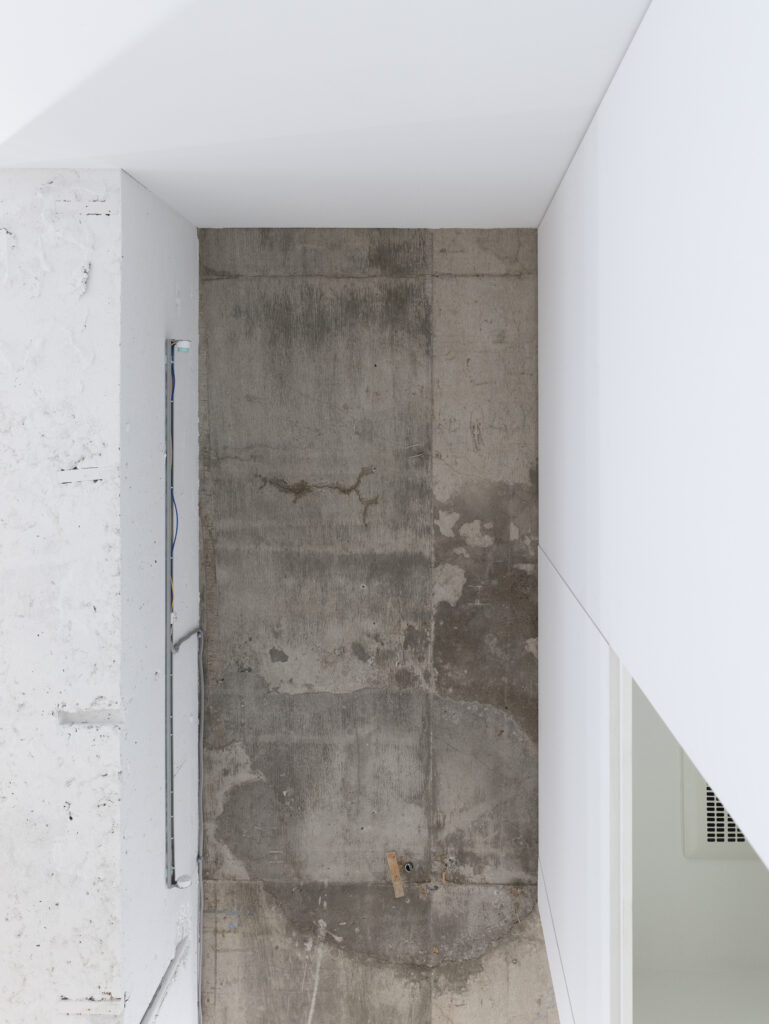
Later that day, I visited the ruins of the Oya Stone Quarry in Tochigi Prefecture to get some confirmation of the strange sensations I felt in that room. The site is popular as a huge man-made underground space, but what I wanted to see were the knife marks left after the stone was quarried. And when I saw the linear marks carved all over the walls, I had the same impression I had in that room. Upon closer inspection, however, it became clear that the two rooms were not similar at all. Although the textures of the Oya stone and the concrete, and the cut marks and niches were similar, the visual image created by combining them was completely different from their composition. In other words, the similarity of their appearance did not mean that they created the same impression.
後日、この部屋で感じた不思議な感覚について、いくばくかの確証を得るために栃木県の大谷石採石場跡を訪れた。地下につくられた人工の巨大な空間として一般に人気のある場所であるが、わたしが見たかったのは石を切り出したあとに残る刃物の痕であった。そして、壁一面に刻まれた直線状の痕を見たとき、やはりあの部屋で感じた印象と同じ印象を抱いたのである。ところが、よく見ていると、それら2つの空間は似ても似つかないものであることが明らかであった。大谷石とコンクリートのテクスチャ、切痕とニッチは、それぞれは似通っているが、それらが組み合わさってできる視覚的なイメージはその構成からしてまったく異なるものであった。つまり、その見た目が似ていたから同じ印象を抱いたというわけではなかったのである。
This is only speculation, but I suspect that such a misperception was caused by the coexistence of multiple bodily sensations. In other words, the tactile sensations of the textures of the stones and concrete, the cuts and niches, and the individual sensations of each, rather than the visual images, were combined in the brain to immediately evoke the memory of the same combination of sensations. However, because the memories were not accompanied by visual images, they were probably overwritten by “dreamy impressions” that were largely based on visual images as they looked at the room in more detail. This is because vision is the strongest of the human senses. Perhaps most interesting is the fact that the tactile sensations triggered by the visual information were mixed together to form a single impression.
憶測にすぎないが、このような印象の錯誤は、複数の身体感覚が並存することによって生じたものではないだろうか。つまり、視覚的なイメージではなく、石やコンクリートのテクスチャ、そして切痕やニッチ、それぞれに対する触覚的な感覚が脳のなかで結びつくことによって、瞬間的に同じ組み合わせの記憶を呼び起こしたのだと考えられる。しかし、視覚的なイメージをともなう記憶ではないため、その後部屋の様子をより詳しく見ていくなかで、視覚的なイメージによるところが多い「夢見心地な印象」に上書きされたのだろう。人間の感覚のなかでもっとも強いのは視覚だからだ。おそらく、ここでもっとも興味深いのは、視覚から得た情報によって引き起こされた触覚的な感覚が混ざり合うことで1つの印象を想起させたということである。
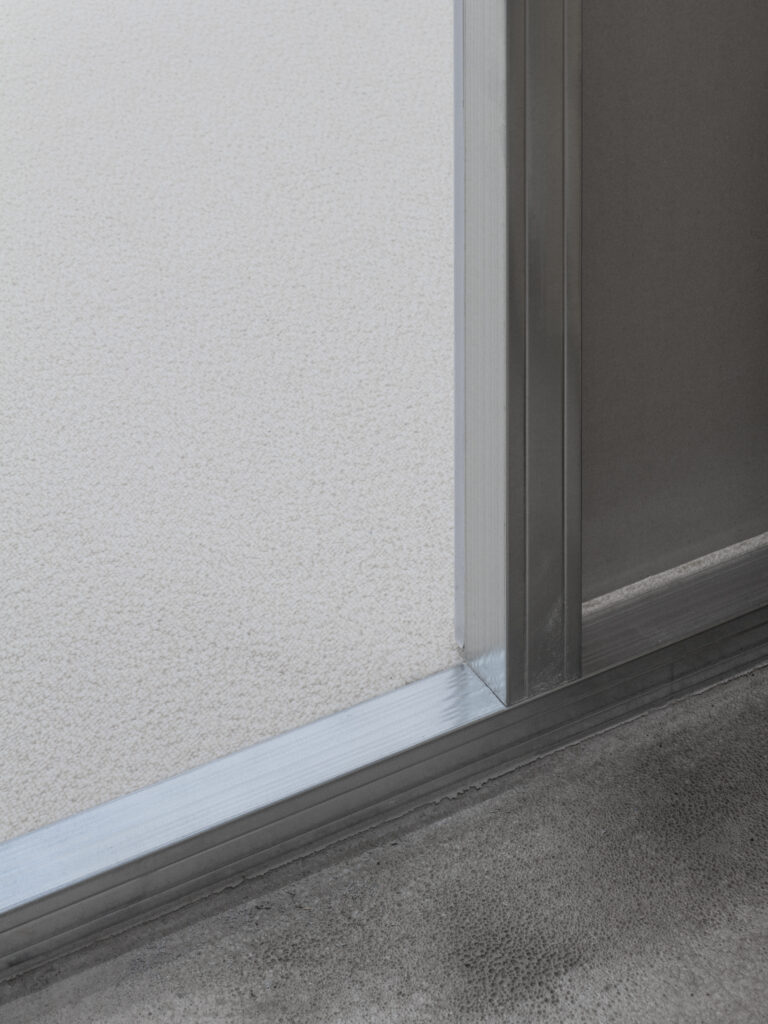
First of all, the fact that visual information influences tactile sensation is well known by the term “mirror neurons”, and many psychological experiments and EEG studies have shown this to be true. We can experience what we see with our eyes as if it were actually happening to us. The fact that we get a shiver down our spine when we see the image of a hand in an insect’s crawling hole, or feel a tickle or pain in our fingertips when we see someone being tickled or their finger being cut with a knife, is evidence that mirror neurons are at work. Argentine artist Lucio Fontana’s famous “Spatial Concepts,” a series of works in which he uses a knife to cut through a canvas, making multiple tears in the canvas, makes us feel as if we are cutting paper or cloth, and for some people, as if our own skin is being cut. Mirror neurons are also activated by simply imagining the scene in our mind without actually seeing it, because when we “imagine” the scene, we already have a visual “image” connected to our brain.
まず、視覚情報が触覚に影響を与えるということは、「ミラーニューロン」という言葉によってよく知られており、多くの心理学的実験や脳波研究によってその実態が明らかにされている。わたしたちは目で見たものを実際に自分の身に起きたこととして追体験できるのだ。虫がうごめく穴のなかに手を差し込む映像を見ると背筋がぞわっとしたり、人がくすぐられているのを見たり、包丁で指を切っているのを見ると、自分もくすぐったくなったり、指先に痛みを感じたりするのが、ミラーニューロンが働いている証拠であるという。アルゼンチンの作家、ルーチョ・フォンタナが制作した、カンバスをナイフで切り裂き、複数の裂け目をいれた《空間概念》という有名な一連の作品があるが、この作品はわたしたちのなかに紙や布を切る感覚を引き起こし、人によっては自身の肌が切られるような感覚を与えるだろう。また、ミラーニューロンは実際に見なくとも、頭のなかでその情景をイメージするだけでも働くが、それは「イメージ」する際にすでに視覚的な「イメージ」を脳のなかに結ぶからだ。
In short, the “quarry-like” impression I had in this room at that moment was caused by the rough texture of the exposed concrete beams (painted white to reveal their presence) and the sensation of pressure and friction associated with the act of cutting that I felt in the cabinets on the walls and in the numerous niches carved into the floor. The sensations of pressure and friction associated with the act of cutting, felt in the same way in the cupboards on the walls and in the numerous niches carved in the footprints, were naturally combined in the brain, evoking and generating the tactile sensations of “roughness” and “cut trench” that one once felt somewhere in a quarry. The impression of space shared in this way is no different from the direct metaphorical reproduction of visual images, nor from the allegorical sharing of narratives attempted through the use of symbolized objects. I would like to tentatively call this phenomenon, in which impressions experienced in different places and at different times are shared instantaneously through tactile combinations alone, without the need for thought or knowledge, “the juxtaposition of physical allegory”. Because tactile memories are weaker and less unique than visual images, they would not evoke specific impressions on their own. It is through the simultaneous experience of multiple tactile sensations that a single impression forms an image. The combination will depend on what the viewer has experienced, and the intensity of its manifestation will vary from person to person. The “juxtaposition of physical allegories” is not only a logical way to construct an impression of space, but also an interesting phenomenon that can create many impressions due to its indeterminacy and indefiniteness.
つまるところ、この部屋で瞬間的に抱いた「石切場っぽい」印象は、(白く塗装されて存在感を露にした)打ち放しコンクリートの梁の荒々しいテクスチャに対して感じた、ざらざらした手触りと、同じく壁一面の戸棚や足元に刻まれた多数のニッチに対して感じた、切るという行為に付随する圧力と摩擦の感覚が脳のなかで自然と結びついたことによって、かつてどこかの石切り場で感じた「ざらざらした」「切堀」の触覚を呼び起こし、生じたのである。このようにして共有される空間の印象は、視覚イメージの直喩的な再生産とも、記号化されたオブジェクトを用いて試みられるナラティブの寓喩的な共有とも異なるものである。異なる場所、異なる時に経験した印象が、思考や知識を必要とせずに、触覚の組み合わせのみによって瞬間的に共有されるこの現象を仮に「身体的寓喩の並置」と呼んでみたい。触覚の記憶は視覚的なイメージよりも弱く、ユニークではないので、単独では特定の印象を呼び起こすことはないだろう。複数の触覚を同時に経験することによって、1つの印象が像を結ぶのである。その組み合わせは、見る人が何を経験してきたかによって異なるだろうし、その発現の強度も人それぞれだろう。「身体的寓喩の並置」は空間の印象を構築的につくり上げる論理的な方法であると同時に、その不確定性と不特定性によって多くの印象をつくり出すことのできる興味深い事象でもあるのだ。
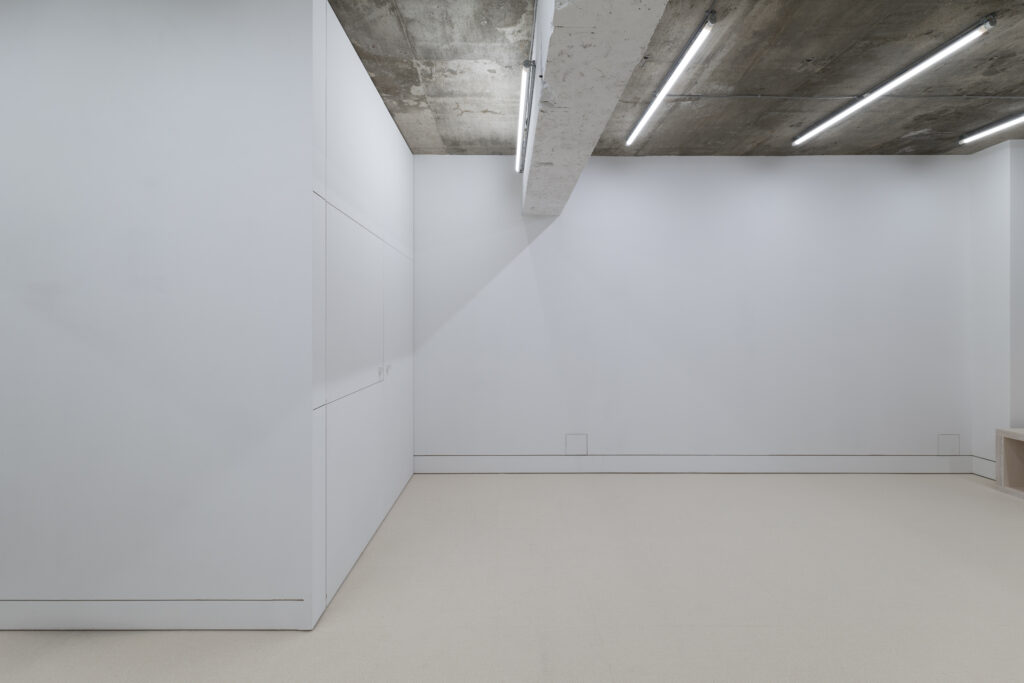
Text: h***** k*******
文:小南弘季